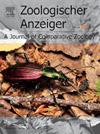巴西地下栖息地中奇异丰富的吉拉迪亚虫(platyhelmintes: Tricladida):砂岩和石灰岩洞穴中的两个新种
IF 1.5
3区 生物学
Q2 ZOOLOGY
引用次数: 0
摘要
大陆三目在南美洲淡水环境中的多样性鲜为人知,对其在新热带地区的分布研究较少。在这篇文章中,我们描述了两个生活在洞穴中的吉拉迪亚新种,并讨论了它们与该属最新系统发育的关系。莫氏吉拉迪亚虫;Leal-Zanchet, sp. 11和Girardia alba Morais &;Leal-Zanchet, sp. 11来自一个单独的洞穴,分别由砂岩(Gruta do Castelo)和石灰岩(Gruna da Pingueira)组成,位于巴西东北部塞拉多和卡廷加之间的过渡地区。帕氏金龟和阿尔巴金龟的标本都有白色的身体和小耳。白斑白斑白斑白斑白斑白斑白斑白斑白斑白斑白斑白斑白斑白斑白斑白斑无眼睛。这两个物种可以很容易地区分彼此,并从他们的同系物的特点的组合。帕氏吉拉迪亚有一个大而不规则的漏斗状球腔,有凹痕和憩室,有一个稍微倾斜的法氏囊管。黄樟有球腔,有不对称分叉部分和有角度的法氏囊管。基于组合分子矩阵(COI + EF1α)的系统发育推断表明,G. patiensis和G. alba形成了一个支持良好的分支,与来自墨西哥的一个未描述的表生种密切相关,后者构成了来自巴西南部的表生种G. schubarti的姐妹群。这两个新物种被归类为穴居动物,并受到威胁,因为Gruta do Castelo (G. patiensis的类型地点)以不受控制的方式被访问,它们发生的地点不断被践踏,而Gruna da Pingueira (G. alba的类型地点)没有法律保护(保护单位),其周围的森林被砍伐。本文章由计算机程序翻译,如有差异,请以英文原文为准。
The remarkable richness of Girardia (Platyhelminthes: Tricladida) in Brazilian subterranean habitats: Two new species from sandstone and limestone caves
The triclads of the suborder Continenticola have little known diversity in freshwater environments in South America, with few studies on their distribution in the Neotropical region. In this article, we describe two new species of Girardia that live in caves and discuss their phylogenetic relationships with the most recent phylogeny of the genus. Girardia patiensis Morais & Leal-Zanchet, sp. nov. and Girardia alba Morais & Leal-Zanchet, sp. nov. are described from a single cave, made of sandstone (Gruta do Castelo) and limestone (Gruna da Pingueira), respectively, located in transition areas between Cerrado and Caatinga in northeastern Brazil. Specimens of both G. patiensis and G. alba have whitish bodies and small auricles. Eyes are small in G. patiensis and absent in G. alba. Both species can be easily differentiated from each other and from their congeners by a combination of characteristics of their copulatory apparatus. Girardia patiensis has a large and irregular, funnel-shaped bulbar cavity with indentations and diverticula and a slightly sloping bursal canal. Girardia alba has a bulbar cavity with asymmetrically bifurcated portions and an angled bursal canal. Phylogenetic inferences based on a combined molecular matrix (concatenating COI + EF1α) indicated that G. patiensis and G. alba form a well-supported clade, closely related to an undescribed, epigean species from Mexico, which constitutes the sister group to the epigean G. schubarti from Southern Brazil. The two new species are categorized as troglobites and are under threat, since Gruta do Castelo (type-locality of G. patiensis) is visited in an uncontrolled manner and the site where they occur is constantly trampled, while Gruna da Pingueira (type-locality of G. alba) has no legal protection (Conservation Unit), and its surroundings are deforested.
求助全文
通过发布文献求助,成功后即可免费获取论文全文。
去求助
来源期刊

Zoologischer Anzeiger
生物-动物学
CiteScore
2.80
自引率
7.10%
发文量
75
审稿时长
>12 weeks
期刊介绍:
Zoologischer Anzeiger - A Journal of Comparative Zoology is devoted to comparative zoology with a special emphasis on morphology, systematics, biogeography, and evolutionary biology targeting all metazoans, both modern and extinct. We also consider taxonomic submissions addressing a broader systematic and/or evolutionary context. The overall aim of the journal is to contribute to our understanding of the organismic world from an evolutionary perspective.
The journal Zoologischer Anzeiger invites suggestions for special issues. Interested parties may contact one of the editors.
 求助内容:
求助内容: 应助结果提醒方式:
应助结果提醒方式:


